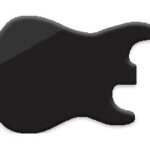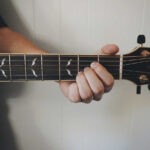Supro Guitars hold a unique and fascinating place in the history of American music. From their humble beginnings in the 1930s to their resurgence in the modern era, these instruments have captivated players with their distinctive sound and undeniable vintage vibe. My own encounter with a Supro Ozark many years ago in a local pawn shop ignited a lasting curiosity about this brand, a curiosity that only deepened when I discovered Jimi Hendrix himself started his guitar journey with a Supro. That missed opportunity to snag a piece of history for just $100 (it was a 1952 Ozark!) still resonates, especially knowing those guitars now command prices ten times that on the vintage market. This article delves into the rich history of Supro guitars, exploring their origins, key models, and enduring appeal for guitarists today.
Jimi Hendrix playing a vintage Supro Ozark guitar, highlighting the early association of iconic musicians with Supro.
The Genesis of Supro: From Resonators to Electric Dreams
The story of Supro guitars is intertwined with the evolution of amplified music itself. Their roots trace back to the National String Instrument Corporation, established in the early 1920s by John Dopyera and George Beauchamp. Driven by the need for louder guitars in ensemble settings, National became a rival to the Dobro Manufacturing Company, founded by Dopyera after his departure from National. The early days of resonator guitars were marked by innovation and competition as both companies sought to amplify the acoustic guitar’s voice.
A vintage 1930s Dobro Angelus resonator guitar, illustrating the early development of resonator technology that preceded Supro electric guitars.
Beauchamp also collaborated with Adolph Rickenbacker, whose tool and die shop played a crucial role in producing components for early resonator guitars, including the aluminum bodies and resonator cones themselves. As the demand for even louder instruments grew, National String Instruments pioneered single resonator steel guitars, setting the stage for future electric innovations.
The financial hardships of the 1930s and the onset of World War II, with its metal rationing, led to a significant shift. In 1942, Victor Smith, Al Frost, and Louis Dopyera (brother of John) joined forces to establish Valco, a new company that would eventually become synonymous with Supro guitars. The name Valco was cleverly derived from the initials of its founders: V(ictor), A(l), L(ouis) Co(mpany).
Valco and the Rise of Electric Supro Guitars
While National had already ventured into electric archtop and lap steel guitars in the 1930s, Valco took the electric guitar concept further. Post-WWII, in 1947, National guitar production resumed, and by 1952, Valco began manufacturing solid-body electric guitars under both the National and Supro brand names. These early Supro electrics were often crafted from wood and sometimes adorned with pearloid plastic finishes, affectionately known as “mother-of-toilet-seat,” a popular aesthetic of the era. Targeting the burgeoning country music scene, Supro guitars quickly found their niche.
A 1952 Supro Ozark guitar, showcasing the early solid-body electric designs and pearloid finishes characteristic of Supro in the 1950s.
Iconic Supro Models of the 1950s: Ozark and Dual Tone
Among the standout models of this era, the Supro Ozark holds a special significance, partly due to its association with a young Jimi Hendrix. The Ozark, like the one I encountered, was initially designed for steel guitar players, featuring a unique pickup where the strings passed underneath, reminiscent of Rickenbacker’s horseshoe pickups. Its single-cutaway body, bolt-on neck, and “Gumby”-style headstock gave it a distinctive look.
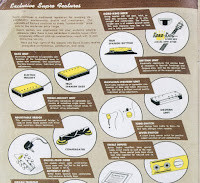
Close-up view of 1957 Supro pickups and guitar features, emphasizing the unique pickup designs and hardware used in Supro guitars.
By 1957, Supro unveiled another iconic model: the Supro Dual Tone. This guitar, instantly recognizable for its dual gold-plated National single-coil pickups, offered individual volume and tone controls for each pickup. Typically equipped with a gold-plated tailpiece and a wooden compensated bridge, the Dual Tone featured a two-position selector switch that allowed players to choose either pickup, but not both simultaneously. The “Kord King” neck, painted to match the body, and Kluson tuners with plastic butterfly pegs completed the vintage aesthetic. Available in black or white with contrasting pickguards, the Dual Tone presented a bold visual statement. While some players found the neck profile rather substantial, the Dual Tone’s sound and style cemented its place in Supro history.
Valco engineer Ralph Keller played a key role in developing a range of pickups for Supro guitars. The True Spanish Bass pickup delivered a warm, clear, and dark tone, ideal for neck positions. The Electric Melody bridge pickup was designed for a brighter, slightly overdriven sound. The Hawaiian-Western pickup, specifically used in the Ozark, produced a midrange-focused tone well-suited for slide guitar.
A Supro True Spanish Rhythm “Silver Sound” pickup, showcasing the innovative pickup designs that contributed to the unique sound of Supro guitars.
Perhaps the most unique of these was the True Spanish Rhythm Unit, also known as the Silver Sound pickup. Often mistakenly described as piezoelectric, it was actually an electromagnetic pickup with a coil in the bridge base and magnetic pole pieces suspended beneath the saddle. This innovative design was an early attempt to capture the nuances of an acoustic guitar’s tone in an electric instrument and was also utilized in National guitars.
Expanding the Supro Lineup: The 1959 Innovations
1959 marked a period of significant expansion for Supro, with the introduction of several new solid-body electric guitars alongside the established Dual Tone and Ozark models. The Supro Rhythm Master boasted two single-coil pickups (Melody and Bass units) and the Silver Sound unit, then referred to as the Spanish Rhythm Unit. Its body shape resembled the Dual Tone but incorporated a subtle upper treble bout cutaway and a German carve around the body’s edge. A single volume potentiometer and a slider switch controlled the guitar’s electronics.
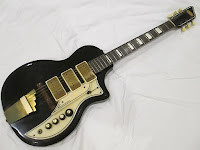
A 1959 Supro Rhythm Master guitar featuring the Val-Trol system, highlighting the innovative control features introduced by Supro.
A particularly unique feature of the Rhythm Master was the Val-Trol system. This Valco innovation consisted of six screw-adjustable mini-pots positioned above the saddle and pickups. These mini-pots allowed players to preset individual volume and tone settings for each string using a screwdriver, offering a level of tonal customization rarely seen at the time. A removable backplate provided access to the electronics.
The Supro Triple Tone, or Tri Tone, featured three single-coil pickups and offered a single volume control and three tone controls. This model was a one-year offering in 1959, making it a relatively rare find today.
While not a solid-body, the Supro Coronado from 1959 deserves mention for its unique design. This maple hollow-body guitar, lacking f-holes and featuring a single cutaway, housed two single-coil pickups (bass neck unit and melody neck unit) and the bridge-mounted Silver Sound pickup. A three-way pickup selector was located on the upper bout, and similar to the Rhythm Master, it featured six adjustable mini-potentiometers beneath the strings.
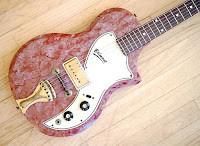
A 1959 Supro Coronado guitar, illustrating the hollow-body designs and unique control layouts that Supro offered in the late 1950s.
The 1959 Supro Belmont essentially presented a single-pickup version of the Dual Tone, equipped with a Melody Unit pickup near the bridge. Often finished in pearloid plastic (“mother-of-toilet-seat”), the Belmont sometimes appeared in solid plastic colors. The Kord King neck on the Belmont featured a Brazilian rosewood fretboard, and the guitar included a compensated wooden bridge. Volume and tone controls, along with a sound-off slider switch, completed the controls.
A vintage Supro Super Series guitar, showcasing the short-scale designs and compact bodies characteristic of the Super Series.
Supro also introduced the Super Series in 1959, featuring short-scale instruments. Available in single and twin-pickup configurations, both versions had a slider switch. On the two-pickup model, the switch selected individual pickups, while on the single-pickup version, it acted as an on/off switch. Stamped metal tailpieces and compensated wooden bridges were standard. To achieve the shorter scale, the same neck used on 25″ scale models was shifted forward, joining the body at the 12th fret, requiring body routing to accommodate the neck extension.
The Supro 33 Special catered to beginner guitarists as a complete outfit. It included a guitar similar to the 1957 Belmont (single neck pickup, plastic cover), a raised scratchplate housing the electronics (eliminating body routing), volume and tone pots on the scratchplate, a wooden compensated bridge, a stamped tailpiece, a small Supro amplifier, and a cardboard case.
The 1960s: Res-O-Glass and Shifting Trends
By 1962, while some Supro models remained consistent, significant changes were underway. The Dual Tone continued unchanged, and the short-scale Super Series was streamlined to a single-pickup model. The Belmont also remained in production without alterations.
However, the 1961-62 Ozark underwent a considerable transformation. Equipped with a Melody unit pickup in the bridge position, the action was lowered, and the body shape incorporated a small upper bout cutaway. Essentially, it became a Belmont with a redesigned body.
A 1962 Supro Ozark guitar, illustrating the design changes and Fire Bronze finish introduced in the early 1960s Ozark models.
The Supro Kingston, a new model for 1962, shared a similar shape and features to the Ozark but utilized a fiberglass body material Valco called Res-O-Glass.
A 1962 Supro Kingston guitar, highlighting the use of Res-O-Glass fiberglass bodies in Supro guitars of the 1960s.
The Supro Coronado II, distinct from the earlier model, also adopted a fiberglass body. The Val-Trol system and bridge-mounted Silver Sound pickup were omitted in favor of a Bass Unit neck pickup and a Melody Unit bridge pickup. A three-way slider switch and individual volume and tone knobs for each pickup provided tonal control.
The Supro Bermuda, a twin-pickup version of the Kingston, featured a molded plastic body, differing from the Res-O-Glass shells of other Supro guitars. Its slider control activated either the neck or bridge pickup, and it had single volume and tone knobs.
A 1962 Supro Bermuda guitar, showcasing the twin-pickup configuration and molded plastic body construction of the Bermuda model.
The 1962 Supro Martinique, also constructed from fiberglass, featured a molded top and bottom with a rubber/plastic gasket. With small upper and deeper lower cutaways, the Martinique was a three-pickup guitar, incorporating a Bass Unit in the neck, a Melody Unit in the bridge, and the bridge/saddle Silver Sound acoustic unit. Master volume and three-way slider switch were located on the lower bout, while Val-Trol tone and volume controls for each pickup (now with regular knobs instead of mini-pots) were positioned above each pickup and bridge. The Martinique, with its larger headstock, represented Supro’s top-of-the-line electric guitar offering.
A 1962 Supro Martinique guitar, highlighting the three-pickup configuration, Res-O-Glass construction, and top-of-the-line features of the Martinique model.
Also new in 1962 was the Supro Pocket Bass, a short-scale bass guitar with a 25 7/8th inch scale (later Airline models extended to 30 inches). This double-cutaway wooden bass featured a single-coil neck pickup and Valco’s Silver Sound unit integrated into the bridge, often mistaken for a piezo pickup. The “Pocket Bass” name referred to routed pockets in the back of the body, covered by a backplate.
A Supro Pocket Bass guitar with the back plate removed, revealing the “pockets” in the body and the internal construction of the bass.
By 1964, the Supro lineup had become more concise. The Coronado II was simply listed as the Coronado, retaining its fiberglass body, two pickups (Bass and Melody units), Kord King neck with rosewood fretboard and block inlays, larger headstock, individual pickup volume and tone controls, three-way slider switch, and Valco vibrato. The Martinique remained unchanged.
New for 1964 was the Tremo-Lectric, a twin-pickup fiberglass guitar with individual volume and tone controls for each pickup. Switches above the pickups selected active pickups, and a small on/off switch activated a battery-powered tremolo circuit. Tremolo speed and intensity knobs, along with master volume and tone controls, offered extensive tonal shaping.
A vintage Supro Tremo-Lectric guitar, showcasing the unique tremolo system and control layout of this model.
The Suprosonic 30 featured a single “Bell Tone” pickup in the neck position, the same double-cutaway body shape as the Pocket Bass, a Valco vibrato, and a red finish with a white headstock.
The 1964 Supro White Holiday was a white fiberglass guitar with a bridge pickup and the bridge-embedded Silver Sound pickup. It had a master volume, slider switch, three tone knobs, and the Valco vibrato, promising three distinct tonal variations.
A 1964 Supro White Holiday guitar, displaying the white fiberglass body and single pickup configuration of this model.
During the folk music boom of 1962-1964, Supro introduced the Hootenanny, also known as the Folkstar. This unique instrument, while not electric, featured a fiberglass body and a single bowl resonator, harking back to National’s resonator guitar heritage.
The Decline and the Modern Supro Renaissance
By 1965, Supro’s catalog included some Japanese-imported models (S525, S535, S545). The S555 retained the pickup arrangement and controls of other models but featured a fiberglass body and a six-on-a-side headstock, suggesting Japanese neck origin. The S430, a six-string version of the Pocket Bass, featured a Bell Tone neck pickup and Valco tremolo, but without the body pockets.
A 1965 Supro Japanese Imports guitar, representing the shift towards Japanese-made models in the later years of the original Supro production.
Budget-friendly models like the Super Seven (short 22″ scale, single center pickup) and Sahara (fiberglass body, bridge pickup, standard 24.5″ scale) were also introduced.
By 1966, Valco increasingly relied on Japanese-imported parts, possibly only retaining the Supro Pocket Bass body. The 1966-67 Pocket Bass shifted to a shorter 24.5″ scale neck.
1967 marked the final year for Valco/Supro guitars and amplifiers, as the company declared bankruptcy. Kay Musical Instrument Company acquired the assets, which were auctioned off in 1969.
However, the Supro story didn’t end there. In 2001, Michael Robinson founded Eastwood Guitars, reviving vintage guitar brands, and acquired the Airline brand name, offering reproductions of Valco instruments. In 2005, Bruce Zinky purchased the Supro brand, focusing on updated Supro amplifiers. And in 2013, Absara Audio acquired the Supro name, currently producing Asian-made reproductions of Supro guitars and amplifiers, bringing the vintage charm and distinctive sound of Supro back to modern players.
A 1965 Supro Sahara guitar, representing the budget-friendly models and fiberglass body construction from Supro’s later years.
The legacy of Supro guitars is a testament to American ingenuity and the enduring appeal of vintage tone. From their resonator guitar origins to their innovative electric models and modern revival, Supro guitars continue to inspire and captivate guitarists seeking unique sound and style.

